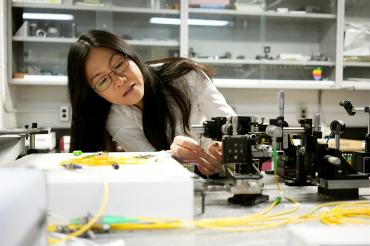U of T researcher joins effort to establish transatlantic quantum communications link

Li Qian is part of an international team of researchers in Canada and Europe developing a blueprint for future satellite-based quantum link technology (photo by Matthew Tierney)
Published: May 2, 2023
Quantum communication links require a delicate touch even over relatively short distances – nevermind across continents. Yet, that’s precisely the challenge taken up by the University of Toronto’s Li Qian and her collaborators.
The three-year international endeavour HyperSpace is one of the largest collaborations yet for the Canadian quantum community.
It brings together researchers in five countries, including partners at U of T, the University of Waterloo, Quebec’s Institut national de la recherche scientifique and several European institutions.
“Establishing a quantum link over such large distances will involve satellites. We’d be sending a couple of photons from Earth’s orbit to ground. It’s quite a challenge and requires various areas of expertise,” says Qian, a professor of photonics in the Edward S. Rogers Sr. department of electrical and computer engineering in the Faculty of Applied Science & Engineering.
At U of T, Qian is working with John Sipe, a professor in the department of physics in the Faculty of Arts & Science whose research focuses on quantum optics and condensed matter physics.
“Our aim is to demonstrate the feasibility of the technology,” Sipe says. “By going through the ups and downs of a satellite mission that integrates the unique demands of quantum communication, we’ll have a solid blueprint in place. Ultimately, HyperSpace is about making quantum applications attractive and realistic in the near future.”
One such application is quantum cryptography that is virtually unbreakable during transmission and offers far better protection than its classical counterpart. While optical fibre can be used for short-reach quantum cryptography, the technology is currently limited to short distances because photons inevitably scatter in optical fibre after about 100 kilometres, degrading the transmission.
While simple amplifiers can boost the transmission signal in classical optical fibre communications, the quantum equivalent of these amplifiers – called quantum repeaters – is still in the early stages of development.
“That’s why grounded optical fibre is no longer feasible if you want to share quantum keys between Toronto and Berlin, for example,” Qian says.
“A quantum satellite is a way to overcome the challenges associated with this very large distance. Such a satellite would also be necessary someday for distributed quantum computing or a quantum internet.”
Qian’s role in HyperSpace’s mission architecture design project is to develop the photon source in space and on the ground. The transmitted photons must be bound with a partner photon, a quantum phenomenon called entanglement. When you measure an entangled photon – no matter how far it may have travelled – you instantly know that its partner shares the same measured property. This strange behaviour of particles in the quantum realm allows for the dramatic information-processing capacity promised by quantum computing.
Since nearly all the photons sent through the atmosphere will be scattered or absorbed – if they aren’t first diffracted by the aperture of the firing telescope – Qian needs to make the very few photons that will reach the destination count.
“Photons can be entangled in multiple ways, in multiple degrees of freedom, and thus carry more information,” she says.
“So we want to entangle not just in polarization, but also in frequency – in theory, that could be up to a hundred colours – or in the temporal domain. We call this hyperentanglement.”
Before transmitting the entangled photons, you need to align the telescopes on the ground and in the satellite – so the HyperSpace team is designing the necessary optical systems to do so with intense beacon lights. The satellite will be following the curvature of the Earth at orbital speed, which makes the angular tolerance very tight, with little room for error.
Once alignment is achieved, the beacon will be shut off and an entangled photon fired into the quantum channel towards the satellite. This procedure must be done at night to mitigate sunlight interference. Even so, cloud coverage, atmosphere, turbulence and distortions will all continue to have a detrimental effect.
“A benefit of projects like these, which I don’t think get talked about enough, is the simple fact that they provide a common goal,” Qian says. “The entire research process – getting top-flight minds working together and generating new ideas – is going to benefit society in some way. You may end up with some technology that can be used in other areas. Maybe the source I’m working on won’t be used for the satellite but something else, such as medical imaging.
“Ultimately, it’s exciting. You meet like-minded collaborators, get to know what they’re doing, learn from each other. That becomes part of the success story.”



